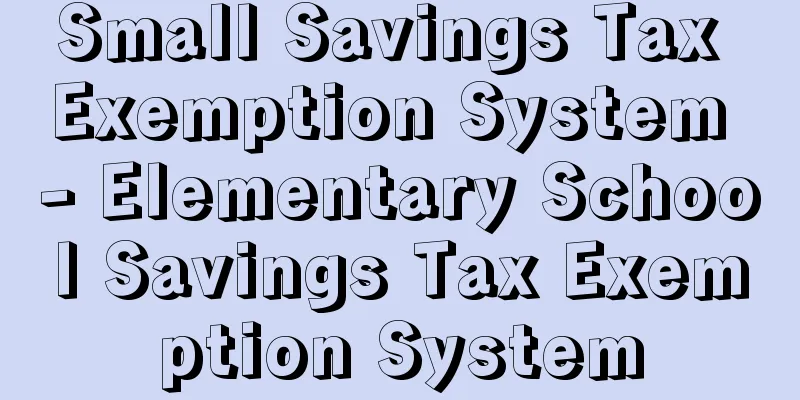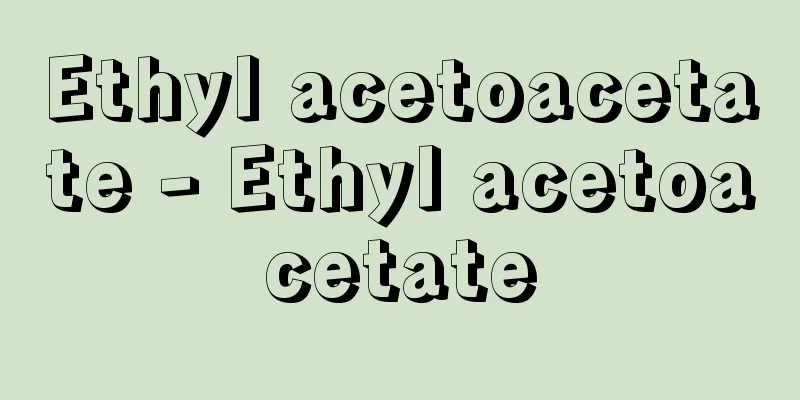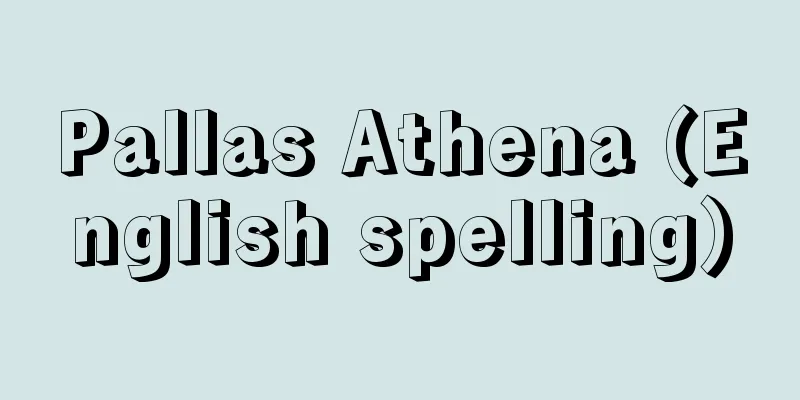Educational Finance

|
It refers to the series of activities carried out by the national and local governments to acquire, manage, and spend the funds (public education expenditures) necessary for the operation of public education in a broad sense. Since the level of public education expenditures secured through education finance determines the quality of educational administration, it plays an important role in the task of practically guaranteeing the right of citizens to receive an education. [Matsui Kazumaro] System typeRegarding the institutional structure of this function, there are three types: independent, integrated, and eclectic, depending on the positioning of the educational administrative agency established as a specialized institution. The "independent type" is a historical prototype that can be seen when public funds were first introduced into education expenses, where educational administrative agencies acquire funds through levies such as education taxes and school taxes, and other methods, and use them for purposes that they themselves deem necessary. This satisfies the classical financial concept of a compulsory acquisition economy based on the principle of quantity and input, but it was unable to cope with the diversification and complexity of administration that accompanied the subsequent development of modern nations, and was reorganized and absorbed into the general financial system amid the trend toward financial unification that comprehensively controls the necessary expenses of various administrative fields. The "integrated type" is a form that functions as a part or a single area of general finance, in which educational administrative agencies are essentially equal to other administrative agencies and have no authority to form financial resources. Therefore, although they receive allocations of necessary expenses, they have little authority over the allocation process. With the exception of the case of the school district system in the United States, educational finance is currently of this type. The "combined type" is the same as the integrated type in that it does not have the right to collect taxes and receives funding from general finances, but it is characterized by strengthening the power of educational administrative agencies in the process of allocating funds, on the premise that educational administration is viewed as a special entity different from other administrative functions. An example of this is the institutional structure of the old Japanese Board of Education Act, which was based on the authority of the head of the local government to prepare the budget, but aimed to achieve relative independence in terms of finances by giving educational administrative agencies the right to submit education-related budget drafts (Article 56 of the same Act), the right to submit dual drafts (Article 58), and the right to execute education-related budgets (Article 60). [Matsui Kazumaro] Current systemSince 1956, Japan's education finance has been integrated, and the education finance system is structured around the authority of general administrative agencies, especially the mayor, rather than educational administrative agencies. In terms of the financial structure, the relationship between the national and local governments regarding specific financial resources, an exception to the principle of burden on the institution, has real meaning. Japan's education finance basically functions along these two axes: the horizontal relationship (between the mayor and educational administrative agencies) and the vertical relationship (between the national and local governments). However, there have been remarkable changes in recent years. The trend of "administrative and financial reforms related to the relationship between the national and local governments" that began at the end of the 20th century and continues today has brought about major changes in the actual state of education finances due to (1) emphasis on local governments (transfer of authority and financial resources to local organizations) and (2) the progress of city, town, and village mergers (a sharp decrease from 3,232 organizations in 1999 to an estimated 1,751 organizations at the end of 2010). Various national treasury subsidies, which are specific sources of revenue for local organizations, have been abolished or reduced, and these amounts have been replaced by local allocation tax grants, which are general sources of revenue. This means that educational administrative agencies will place more importance than ever on their relationships with local leaders. [Matsui Kazumaro] Horizontal RelationshipUnder a budget system in which all revenues and expenditures are incorporated, public education expenditures are nothing but education-related expenses included in the expenditure budget. Looking at the process for deciding public education expenditures in local governments, it is as follows: (1) the Board of Education submits a budget request, (2) the head of the local government assesses the request, (3) the Board of Education listens to the opinion of the head of the local government on the assessment, (4) the head of the local government prepares a budget proposal, (5) the budget proposal is sent to the assembly for deliberation, and (6) the assembly passes the proposal. Of these, (3) is considered essential as a prerequisite for (4), but since the opinion of the Board of Education is not binding, the authority over education finances is essentially in the hands of the head of the local government. [Matsui Kazumaro] Vertical RelationshipIn principle, local governments are to cover all expenses incurred in their administration (Article 9 of the Local Finance Law), but national funds are given to local governments through the Local Allocation Tax Grant System and the National Treasury Subsidy System. The former funds are general revenue sources for local government revenues, while the latter funds are specific revenue sources. Both are financial security measures to cover the weakness of local government finances, and they also play an important role in forming public education expenditures. The national treasury subsidy system, which is carried out in the form of both legal and budgetary subsidies, has been criticized for its nature of allowing the central government to control local governments through the decision-making process for subsidized projects, and has been replaced by Local Allocation Tax Grants. However, educational administrative agencies that aim to maintain education standards are required to build even closer relationships with local leaders in order to raise educational financial funds. [Matsui Kazumaro] [Reference items] | | | |Source: Shogakukan Encyclopedia Nipponica About Encyclopedia Nipponica Information | Legend |
|
国および地方公共団体が広義の教育行政、すなわち公教育の運営に必要な資金(教育公費)を取得・管理・支出する一連の活動の総体をさしていう。教育財政を通して確保される教育公費の水準が教育行政の質を規定するものである以上、国民の教育を受ける権利の実質的保障という課題にとって、重要な役割を担っている。 [松井一麿] 制度類型この機能の制度構造については、専門的機関として設置される教育行政機関の位置づけによって、独立型、統合型、折衷型の3類型がある。 「独立型」は、教育経費に公費が導入され始めた時期に認められる歴史的原型であって、教育行政機関が教育税、学校税などの賦課その他の方法で資金を獲得し、自ら必要と認めた使途にそれを充当する。ここでは量出制入原則に基づく強制獲得経済という古典的な財政概念要素は満足されているが、その後の近代国家の展開に随伴する行政の多様化複雑化に相応できず、行政諸分野の所要経費を統合的に支配する財政一元化の趨勢(すうせい)のなかで、一般財政システムに改組吸収されていく。 「統合型」は、一般財政の一部分あるいは一分野として機能する形式で、教育行政機関は他の行政機関と原理的には等置され、財源形成権能はなく、したがって所要経費の配分は受けるが、配分のプロセスにかかわる権能も小さい。アメリカの学区制度下の事例を除けば、教育財政は現在この型となっている。 「折衷型」は、徴税権がなく、一般財政から資金配分を受けるという点では統合型と同じであるが、教育行政を他の行政と異なる特殊性格でとらえることを前提として、資金配分過程での教育行政機関の権能を強化した点に特色をもつ。日本の旧教育委員会法の制度構造がその事例で、地方公共団体の長(首長)の予算調製権を基盤としながら、教育関係予算原案提出権(同法56条)、二重原案提出権(58条)、教育関係予算執行権(60条)などを教育行政機関に与えることによって、財政面における相対的独立を企図したのであった。 [松井一麿] 現行制度1956年(昭和31)以降日本の教育財政は統合型をとっており、教育財政制度は教育行政機関より一般行政機関とくに首長の権限にかかわって組み立てられている。また財源構造では設置者負担主義の例外としての特定財源に関する国と地方の関係が実質的意味をもってくる。この横の関係(首長と教育行政機関)と縦の関係(国と地方)の二つの座標軸に沿って、基本的に日本の教育財政が機能している。 しかし、近年の変化は著しい。20世紀末に始まり、今日なお続いている「国と地方の関係に関わる行財政改革」の趨勢は、(1)地方の重視(地方団体への権限と財源の委譲)と、(2)市町村合併の進行(1999年時の3232団体から2010年末見込の1751団体への激減)により、教育財政の実態に大きなさま変わりをもたらしている。地方団体にとって特定財源となる各種国庫補助金が廃止もしくは削減され、その分が一般財源である地方交付税交付金に切り替えられる。このことは教育行政機関にとって、従来以上に首長との関係が重視されることとなる。 [松井一麿] 横の関係歳入歳出のすべてを編入する予算制度のもとでは、教育公費は歳出予算に計上された教育関係費にほかならない。教育公費の決定過程を地方公共団体についてみると、(1)教育委員会の概算要求、(2)これに対する首長の査定、(3)査定に関する教育委員会意見の聴取、(4)首長の予算案調製、(5)議会への予算案送付および審議、(6)議会の議決による成立という行程となる。このうち(3)は(4)の前提として不可欠とされるが、教育委員会の意見に拘束力が認められていないため、教育財政に関する権限は実質上首長の手に握られている。 [松井一麿] 縦の関係地方公共団体の行政に要する経費は、当該団体が全額負担する(地方財政法9条)のが原則であるが、地方交付税交付金制度および国庫補助金制度によって国の資金が地方に与えられる。地方公共団体の歳入において前者による資金は一般財源、後者による資金は特定財源となり、いずれも地方公共団体の財政力の弱体性をカバーする財源保障措置であって、教育公費の形成にも重要な機能を果たしている。法律補助、予算補助両様の形式で行われる国庫補助制度が、補助事業の決定行程を通して中央の地方支配を可能にする性格を備えている点が問題とされ、地方交付税交付金に置き換えられてきているのであるが、教育水準の維持を図る教育行政機関にとって、教育財政資金の調達のため、首長との一層緊密な関係構築が求められる。 [松井一麿] [参照項目] | | | |出典 小学館 日本大百科全書(ニッポニカ)日本大百科全書(ニッポニカ)について 情報 | 凡例 |
<<: Education Reform Committee
>>: Educational civil servant - Kyoiku Koumuin
Recommend
Gottschalk, L.
...From the middle of the 19th century, European ...
Objective
…English words like event and matter, German word...
Third generation successor
One of the greatest masterpieces of Toei's yak...
Daniel Barenboim
Israeli conductor and pianist. Born in Buenos Air...
Potash rock salt - Kariganen (English spelling) sylvite
A mineral that occurs as a minor component of roc...
Bergman, TO (English spelling) BergmanTO
...However, the "molecular theory" was ...
"Essa Mainichi Shimbun" - Essa Mainichi Shimbun
…Born in Nagaoka, Echigo Province. After running ...
King Yongle
… He was the son of King Yang of the country, and...
New Japanese Literature
The journal of the New Japan Literary Association...
Sam Sene Thai (English spelling)
…The first king, Fa Ngum, whose capital was Muang...
Duvet (English spelling) (French) duvet
A feather duvet (meaning bird fluff) or a bed cove...
Chiara, G. (English spelling) ChiaraG
…His real name was Giuseppe Chiara. He was an Ita...
Horeki calendar - Horekireki
A lunar calendar that was in effect from 1754 to 1...
Strasburger, Eduard Adolf
Born: February 1, 1844 in Warsaw Died May 18, 1912...
Matsunaga Hisahide
Year of death: Tensho 5.10.10 (1577.11.19) Year of...









